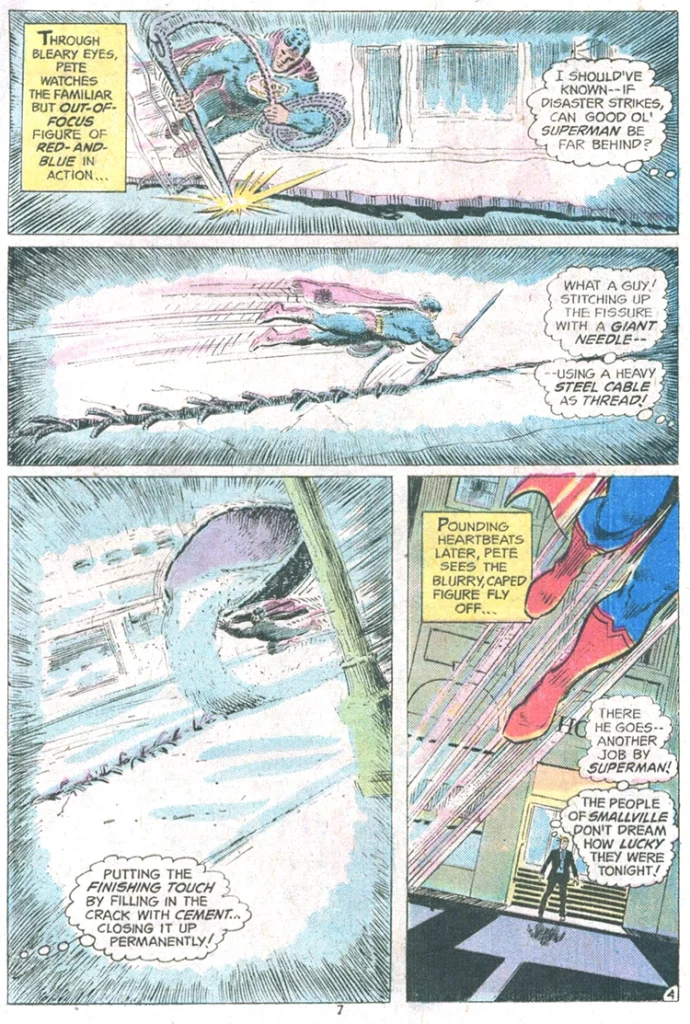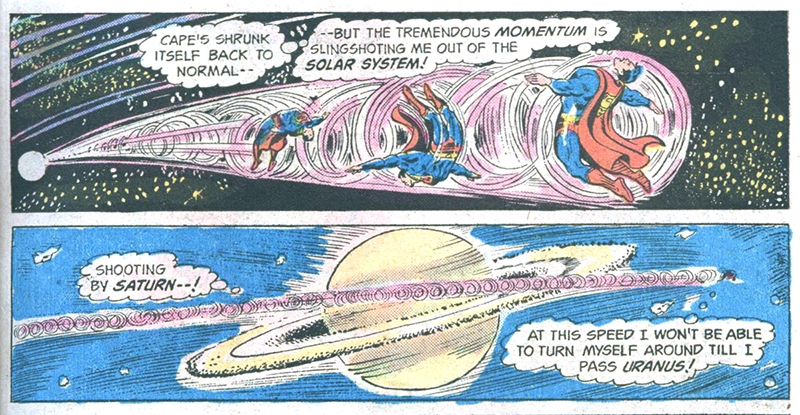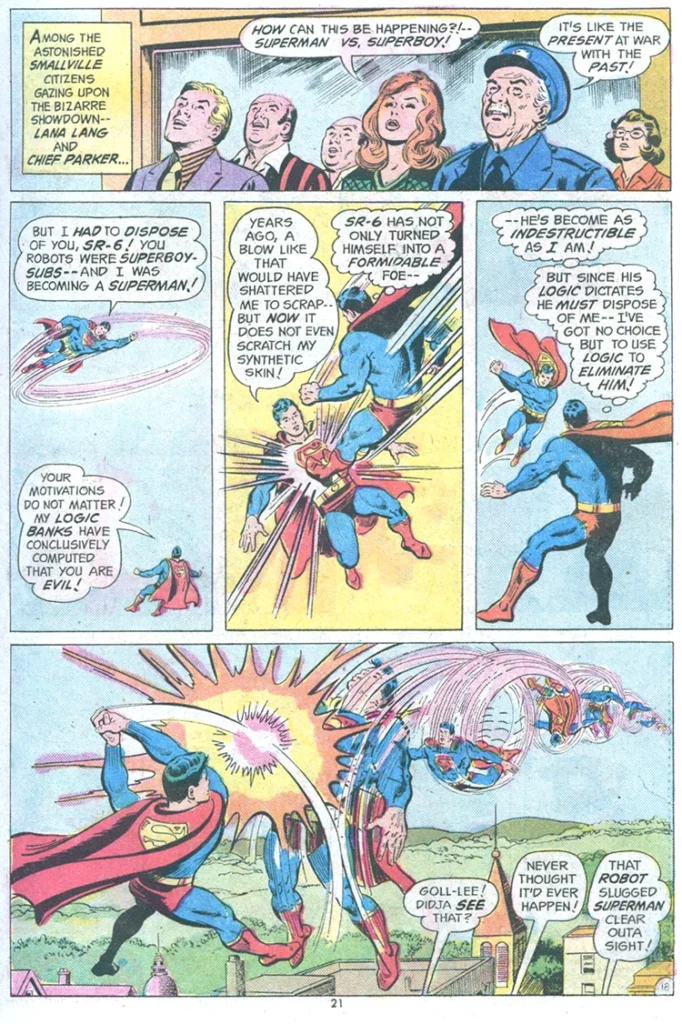LINKS
- Attack of the 50-Year-Old Comics
- Super-Team Family: The Lost Issues
- Mark Evanier's Blog
- Plaid Stallions
- Star Trek Fact Check
- The Suits of James Bond
- Wild About Harry (Houdini)
Fifty years ago this month, Superman #284 appeared on newsstands, and young me was happy to get it. In something of a homecoming for the Man of Steel, the story sees Clark Kent reuniting with two cherished childhood friends to learn the truth behind “The Secret Guardian of Smallville.”
We open in Metropolis, where Superman takes a call from his old pal Pete Ross while leaping into his Clark Kent trousers in a maneuver I would attempt many times without success. But then again, I don’t possess super-speed or the power of flight.

Younger readers should note that in the days before personalized ring-tones, it would indeed have been an impressive super-feat for our hero to ID the sound of Clark’s desk phone over all the other identical and likely also ringing phones in the WGBS building, but hey, he is Superman after all.
Later, Pete is taking a midnight stroll outside of the Smallville hotel when an earthquake suddenly hits the town, ripping a fissure along the main street and sending loose bricks down onto poor Pete’s noggin. Groggy from the blows, Pete spies through blurry vision a blue and red figure undoing the quake damage and concludes his old pal has arrived early.

The next morning, Pete is inspecting the perfectly-repaired street when Clark drives up and shares that he’s only now arriving since he couldn’t get away from Metropolis the night before. Pete just smiles and thinks, “Same old Clark — Covering up the fact that he was here last night…as Superman!” (I should perhaps note here that as a boy, Pete accidentally learned Clark’s secret identity but kept it to himself so as to better aid his pal, which I always found to be one of the most endearing and heartwarming sidebars of the Silver Age Superman mythos).
Heading to the library, the two old friends link up with a third: the lovely Lana Lang. Having dug into recent Smallville history, she finds it odd that the town has been blessed with remarkable good luck for years, with no natural disasters or crimes of note. If like me you grew up in small towns, you might not consider this lack of drama all that remarkable – indeed there were times I would’ve welcomed a spectacular heist or minor natural disaster just to break the monotony – but keep in mind that when a certain super-powered teenager was around, Smallville was Ground Zero for countless odd occurrences from collapsing bridges to hi-tech crimes to alien invasions, so peace and quiet is a new development.
As if on cue, a helicopter appears over the Smallville Bank and Trust, blasting a hole in the building’s roof and hoisting the safe out with a huge magnet. Knowing that Clark is itching to intervene, Pete helps out by delivering a “gentle nerve pinch” to Lana’s neck, rendering her unconscious (all those reruns of Star Trek have paid off!). He tells Clark she must have fainted from the excitement.
Seizing the opportunity, Clark rushes off and changes to Superman, flying after the chopper only to be intercepted by…well, something that whizzes past at super-speed, grabbing his cape and stretching it to a ridiculous length, then letting go, causing it to snap like a rubber band and send our hero hurtling through outer space.

Ha ha, look: He said… Ahem, yes, well, moving right along, the escaping crooks can’t believe their good luck, but that changes quickly as a mysterious red-and-blue blur causes their helicopter’s rotors to fly off, sending the aircraft plummeting to Earth. To a man, the crooks all pass out (as I’d like to hope I would in a crashing aircraft) but then awaken in the street, safe and sound but with their hands bound, just in time for 75-year-old Police Chief Parker to cart them off to the pokey. Superman returns from space in time to witness this outcome and is sorely perplexed, given he had nothing to do with it. Maybe someone…or something…really is acting as Smallville’s secret guardian?
Pete fills in Lana on what she missed and Lana shares that Superman had solved a similar chopper caper only the night before in Metropolis. Reading the newspaper account, Pete realizes the Metropolis incident occurred at exactly the time he thought he saw Superman in Smallville. This triggers an epiphany for Pete, who rushes off to the old Kent home to check out his theory. Sure enough, he finds a Superboy robot in the house, still operational and with a decided chip on his shoulder, seeing as how his master had tried to kill him years before by flying him through the sun.

Suddenly the robot is alerted to a disturbance in town and flies off to find a sonic boom has done minor damage to some shop windows. It turns out Superman caused the damage on the theory it would draw out Smallville’s mysterious guardian, who he now recognizes as “Superboy Robot-6.” The robot declares his intention to “eliminate” Superman seeing as how he’s an “evil being” but Superman reminds him that as a robot, he’s not as powerful as the real deal. However the robot reveals he’s enhanced himself with upgrades that make him the equal of his former master, and the battle is joined.

Then follows a fairly lively battle by Bronze Age Superman standards, with the two opponents evenly matched. When a powerful punch sends Superman spinning off over the horizon, Chief Parker decides to intervene and cuff the errant robot himself. It doesn’t go well for the septuagenarian lawman.

Convinced he’s brought about the policeman’s death, the robot concludes he himself is evil and therefore flies into the sun, deliberately short-circuiting his invulnerability upgrade so the star can reduce him to ashes. Meanwhile, a gathered crowd is amazed to see the freshly deceased “Chief Parker” leap to his feet and reveal himself as Superman, having stopped his heart on demand to simulate death and fool the robot. Later, Pete, Clark and Lana reason that everything’s turned out for the best and Smallville will just have to solve its own problems like every other small town. The End.
I’ve always had mixed feelings about this story. On the one hand, it’s tightly constructed and moves along quickly at a mere ten pages. Curt Swan’s art is always a joy and here he’s ably inked by Bob Oksner, applying his usual talent for drawing attractive women to give us a truly adorable Lana. Plus, it’s always fun to see our hero in a knock-down, drag out battle with an evenly-matched foe.
On the other hand, it’s hard not to sympathize with poor old Superboy Robot-6 and indeed it’s debatable whether he isn’t right about his master being the bad guy, here. It comes off as callous at best for Superman to destroy his faithful robots for the simple crime of being stuck with the “teen-age” appearance he gave them. You’d think if he had the skill to build lifelike bodies, he could also upgrade them to look older. After countless stories wherein the Superboy and Superman robots exhibit loyalty, ingenuity and at times self-sacrifice, IMO they seem to come awfully close to true sentience, thinking quickly and creatively and risking all for their creator. These are not mere mannequins our hero operates with super-ventriloquism; their actions are self-guided once a mission is assigned and their solutions to crises are often as clever as Superman’s would be, as the hero himself notes about Robot-6’s approach to the helicopter crooks in this issue. So then how is it cool to just casually scrap them like you’re tossing last years’ model smartphone into a landfill?
Robot 6 in particular shows an extra spark of self-awareness that his comrades arguably lacked. Unlike his peers, he transcends rote programming to arrive at a personal judgement: if murder is evil, and if he is alive, then Superman is evil for trying to murder him. Does this sort of “free thinking” simply equate to a “bug” in his programming…a mere system error? Or does it reflect an extra spark of independent thought that elevates him from machine to intelligent lifeform? The only way the story works is if we accept that by definition any artificial life form cannot be truly alive and that if there’s one that thinks it is, then it’s obviously suffering a malfunction. But I think it can be as easily argued that this particular robot has somehow made the leap to true awareness and independent sentience, and indeed maybe thinking you’re alive is all that’s required to *be* alive (I think, therefore I am).
What is it that separates the inanimate from the truly “alive”? A human corpse has everything it takes to make a person *except* the spark of life. What accounts for that spark? Who can explain what it is or where it originates? What if it were to inhabit a different form, one with metal rods instead of bones, circuits instead of synapses, sensors instead of nerves? Does it not “count” as alive because it’s non-organic?
Interestingly, this story reinforces a recurring theme in the mythos, wherein Superman’s famous code against killing goes out the window when the life form in question is non-human. Twelve years earlier in Action Comics #292, he even helps Luthor escape punishment for murder on a world of machine beings who have not only achieved sentience but have actually developed a very Earth-like justice system based on trial by jury, a system Superman willfully obstructs, apparently only because its architects aren’t organically based beings. Luthor can’t be punished for taking a life, he reasons, if that “life” belongs to a being made of gears and wires and not flesh and blood. But I’d argue it doesn’t really matter whether he thinks their lives are worthy of civil rights and judicial process; what matters is *they* think so. And he doesn’t care.
Back in Superman #163, a Superman robot had its intelligence transferred to a “chemically based” super-android body by aliens and went by the name “Wonder Man.” Though initially a foe, he ends dies saving Superman, leading a grateful Man of Steel to erect a monument in his honor with the inscription, “He was born a robot…but he died a man.” This despite having the same brain in either body. So I guess with less – or anyway more advanced – gears and sprockets involved, Wonder Man nee Superman Robot magically moves up the ladder in Superman’s estimation. At least he fares better than the alien who takes control of Perry White in Action Comics #278. Supergirl refers to this creature as “a plant intelligence” and Superman executes it with White Kryptonite (fatal to all plant life), offering the decidedly unsentimental epitaph, “That’s the end of YOU!” So while Superman technically professes a vow against taking a life, the caveat is that he gets to decide what qualifies as life. Humanoid? You may be safe. Merely sentient? You take your chances, buster.
As an aside, you can tell Star Trek was a big deal in pop culture back in 1974. Besides Pete borrowing the Vulcan nerve pinch from Mr. Spock (making him one of the very few humans able to master the technique), Superman obviously rips a page from Captain Kirk’s playbook in tricking an errant “computer” into self-destruction via logic. In particular, this story owes much to “The Ultimate Computer,” wherein the destructive M-5 super-computer has to be convinced it’s broken its own moral code and thus must self-terminate. But where the M-5 had inherited its creator’s grandiose egotism and paranoia, resulting in errors of judgement that cost many lives, Superboy Robot-6 has inherited only his creator’s moral code against killing and his altruistic desire to aid others. Not only is he not a threat to the world, he’s done a lot of good for Smallville. The famous “uncanny valley” effect also factors in when comparing the two tales; M-5 looked like a big metal box, so we never felt too attached to it, while in contrast, Superboy Robot-6 looks and acts like a human being. Thus, where it feels like Kirk is simply “pulling the plug” on a malfunctioning device, Superman’s spin on the same tactic plays more like an execution.

So did I like the issue? Yes, I did, on balance. But it also unsettled me as a kid who tended to project human qualities even onto objects that didn’t look human let alone a robot that very much did, and it still leaves me a bit conflicted 50 years on, after exposure to the more sympathetic take on the rights of artificial life forms seen on by Star Trek: The Next Generation. Maybe there’s even a timely angle to this story in 2024 as we consider the rise of AI and fears of the imminent “technological singularity”: will we be ready when computers decide they have as much of a claim on life as we do, if not more? What will happen when the creations confront their creators?
Or maybe this was just a fun story with pretty pictures, packaged with 90 additional pages of cool reprints, all in glorious color for a mere 60 cents. And maybe that’s enough. It sure was in November of 1974.